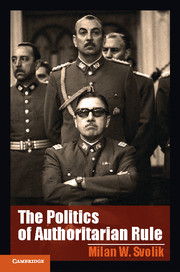Book contents
2 - The World of Authoritarian Politics
Published online by Cambridge University Press: 05 November 2012
Summary
[We] have next to consider how many forms of government there are, and what they are. … Tyranny is a kind of monarchy which has in view the interest of the monarch only; oligarchy has in view the interest of the wealthy; democracy of the needy. None of them the common good of all.
Aristotle, Politics, Book 3Happy families are all alike; each unhappy family is unhappy in its own way.
Tolstoy, Anna KareninaThe President lives here [at the Chapultepec Castle], but the man who gives orders lives across the street.
A wisecrack during the Maximato (1928–1934)Dictatorships come in many shapes and sizes. For seventy years, Mexican leaders came from only one party, the Institutional Revolutionary Party (PRI), but nevertheless left office every six years after regular, albeit flawed, elections. Meanwhile, in Argentina, a junta of generals designed elaborate rules about how to share power, only to abandon them after they took office in 1976, governing for the next seven years in quick succession and by crude repression. And in North Korea, a dynasty of fathers and sons has ruled for decades, each dying on the throne after maintaining a personality cult reminiscent of premodern despotism. In short, dictatorships come with a variety of institutions, leaders, and outcomes: They may have legislatures, parties, and even elections; they exist in some of the poorest but also some of the wealthiest countries around the world; and their leaders may wear a crown or a military uniform and stay in office for days or decades.
- Type
- Chapter
- Information
- The Politics of Authoritarian Rule , pp. 19 - 50Publisher: Cambridge University PressPrint publication year: 2012



